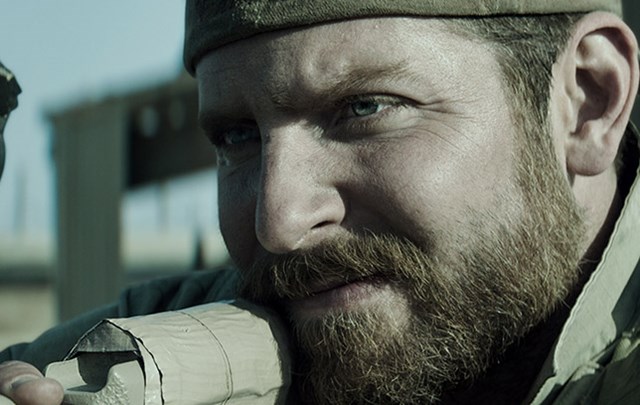
Every guy who’s ever picked up a barbell understands how hard it is to gain even 5 kilograms of muscle. Now imagine the challenge of packing on 18 solid kilograms, the weight of an average five-year-old.
That’s what Bradley Cooper set out to do when he took the lead role in American Sniper. The movie is based on the autobiography of Chris Kyle, the Navy SEAL credited with a record 160 confirmed kills in Iraq. Kyle was a 105-kilogram Texan who was not just fearless in combat, but the kind of real-life badass who would practice MMA-style choke outs with his fellow SEALs for fun.
“I had to get to the point where I believed I was him,” Cooper says. “At 83 kilograms, it would’ve been a joke. His size was such a part of who he was.”
So the two-time Academy Award nominee had to do something they don’t teach you at the Actors Studio, where he earned his master’s degree: get bigger. A lot bigger, with a process that culminated in a very specific type of bigness. “Chris wasn’t ripped,” Cooper says. “He wasn’t sinewy. He was just a bear.”
But that wasn’t the only challenge Cooper brought to his trainer, Jason Walsh: he needed to pull off this epic transformation in just 10 weeks, “with the least amount of damage to my body,” he adds.
The Monster Builder
From the outside, the life of the celebrity trainer looks pretty sweet. Walsh, owner of Rise Nation in West Hollywood, has a roster of red-carpet clients that includes Jessica Biel, Jennifer Garner, and Ben Affleck. On a normal day he might spend quality time with Victoria’s Secret model Rosie Huntington-Whiteley or actress Emily Blunt.
It was Blunt’s husband, actor John Krasinski, who connected Cooper to Walsh. The two actors were in Hawaii, shooting an as-yet-untitled comedy in which Krasinski, best known for playing Jim Halpert in The Office plays a muscled-up military man who happens to be married to the ex-wife of Cooper’s character. “He had to be as big as possible,” Cooper says. “He showed up and he was a monster.”
Cooper was impressed enough with the transformation that he wanted to work with the trainer responsible for it.
By contrast, his own character in that movie “was a guy who’d been basically in traction,” he says. “He was a guy you could tell had been beaten down a bit.” Thus, his training for the role consisted mainly of not training. He avoided lifting anything heavier than a kayak paddle during his time in Hawaii, and then went straight from playing that guy to training with Walsh for his role in American Sniper.
In addition to the not-lifting-for-months handicap, the 39-year-old actor started with significant issues. “He came to me with back and shoulder problems,” Walsh says. “He had some major, major imbalances.”
Most trainers, faced with the challenge of accomplishing so much in so little time, would find a way to work around the problems. Not Walsh. “When clients come in and they have issues, we don’t work around the issues,” he says. “We fix the issues.”
It’s a lesson he learned in an entirely different context: training football players for the NFL.
Working Off The Gridiron
Walsh began his coaching career at the University of North Carolina, where he worked with athletes in the Olympic sports, which include swimming and track and field. From there he went west to Athletes’ Performance in Arizona, where he worked with owner Mark Verstegen to prepare his clients for the 2006 Combine.
“I was more or less a volunteer,” Walsh says. “I feel like Mark is a visionary, and I went out there to raise my level of knowledge.”
The biggest takeaway: that strength training involves a lot more than making people stronger. “It’s about longevity,” he says. “It’s about keeping the athlete on the field.” He calls what he learned “true training,” and finds it works just as well with elite actors as elite athletes… with one important difference: “Athletes are used to the pain. But for actors, it’s a whole new world.”
Walsh started Cooper off with corrective movements, as he would with an athlete. They trained twice a day. In the first workout, beginning at 5 a.m., they focused on structural exercises like deadlifts and squats to build a foundation solid enough to hold the extra mass. The second workout, late in the afternoon, was more focused on traditional muscle-building exercises. Cooper needed both types of training to convincingly portray Chris Kyle.
“Chris was a big guy,” Walsh says, using the past tense because Kyle was murdered by a fellow veteran in 2013 at a shooting range in Texas. “Most Navy SEALs aren’t, but he was one of the bigger ones.”
The challenge went beyond bulking Cooper up from 83 to 102 kilograms. He had to move like he belonged in that body. For that, Walsh relied heavily on unilateral exercises, like Bulgarian split squats, starting with body weight only and building up from there. They also did a lot of single-leg deadlifts, including the Romanian deadlift with a landmine, a piece of training equipment that looks like home plate with a rotating metal tube in the middle, which holds a barbell.
Breakfast (and lunch, dinner, and snacks) Of Champions
All that training would’ve accomplished little without lots and lots of food, more than 5,000 calories a day. “Bradley was coming off a movie where he had to be smaller,” Walsh says. “We had to force-feed him. That was the hardest part.”
Cooper agrees. “It was a real shock to my body. If it’s pizza and cake, that’s one thing. Putting 6,000 calories a day in your body gets old quick.”
His personal chef prepared five daily meals, but even that wasn’t enough. They supplemented with Plazma, a pre- and post-workout drink, and energy bars, both of which provide a combination of carbs and protein.
“Without that kind of caloric intake and the ability to recover, he probably wouldn’t have made it,” Walsh says. “His body just absorbed everything I threw at it.”
By the end of their program, Cooper had worked up to heavy rack pulls, a deadlift variation using a hex bar that starts a few centimetres above the floor. “That was our big lift,” Walsh says. Director Clint Eastwood even uses it in the movie, in a workout scene. (Walsh can be seen in the background, punching a heavy bag.)
At his peak, Cooper could crank out five sets of 8 reps with more than 180 kilograms – close to double his body weight. “You could see him becoming Chris Kyle. His beard grew, and he just got burly. He looked forward to coming in every day and seeing what he could do.”
Cooper found life as a heavyweight to be a revelation. “It changes absolutely everything,” he says. “It changes the way you walk, the way people relate to you. If someone bumps into you on the sidewalk, they kind of ricochet off. You go to a party and everyone’s dancing, you’re not being moved by anybody.”
There were also downsides, like outgrowing his entire wardrobe, and wearing a pair of pants with an elastic waist almost every day. “Even my hands got bigger,” he says. “I wear my father’s wedding ring, and I couldn’t wear that anymore. It wouldn’t fit.”
What Goes Up…
The transformation, though, was temporary. Soon after American Sniper wrapped, Cooper had to take the weight off for his next role, in which he plays a chef. “I shed about 6 kilograms in three weeks,” he says. “The next 6 to 10 kilograms were really hard to lose.” Because he lost the weight while shooting the still-untitled movie, he figures the editors have their work cut out for them when they try to make him look the same size in every scene.
He went from there to Broadway, where he’s back down to his customary 83 kilograms to play the title role in The Elephant Man, which may be as far as an actor can get from a warrior like Chris Kyle.
The benefits of being himself again – eating normally, wearing his own clothes – don’t erase the satisfaction of having been a much larger self, at least for a while. “I knew this was going to be the way in to playing Chris, and it felt amazing,” he says. “It’s also nice to know it’s possible to do it naturally, in that amount of time.”
But when asked if he wanted to return to the kind of training that made his transformation possible, his answer is simple and emphatic: “Absolutely not!”















